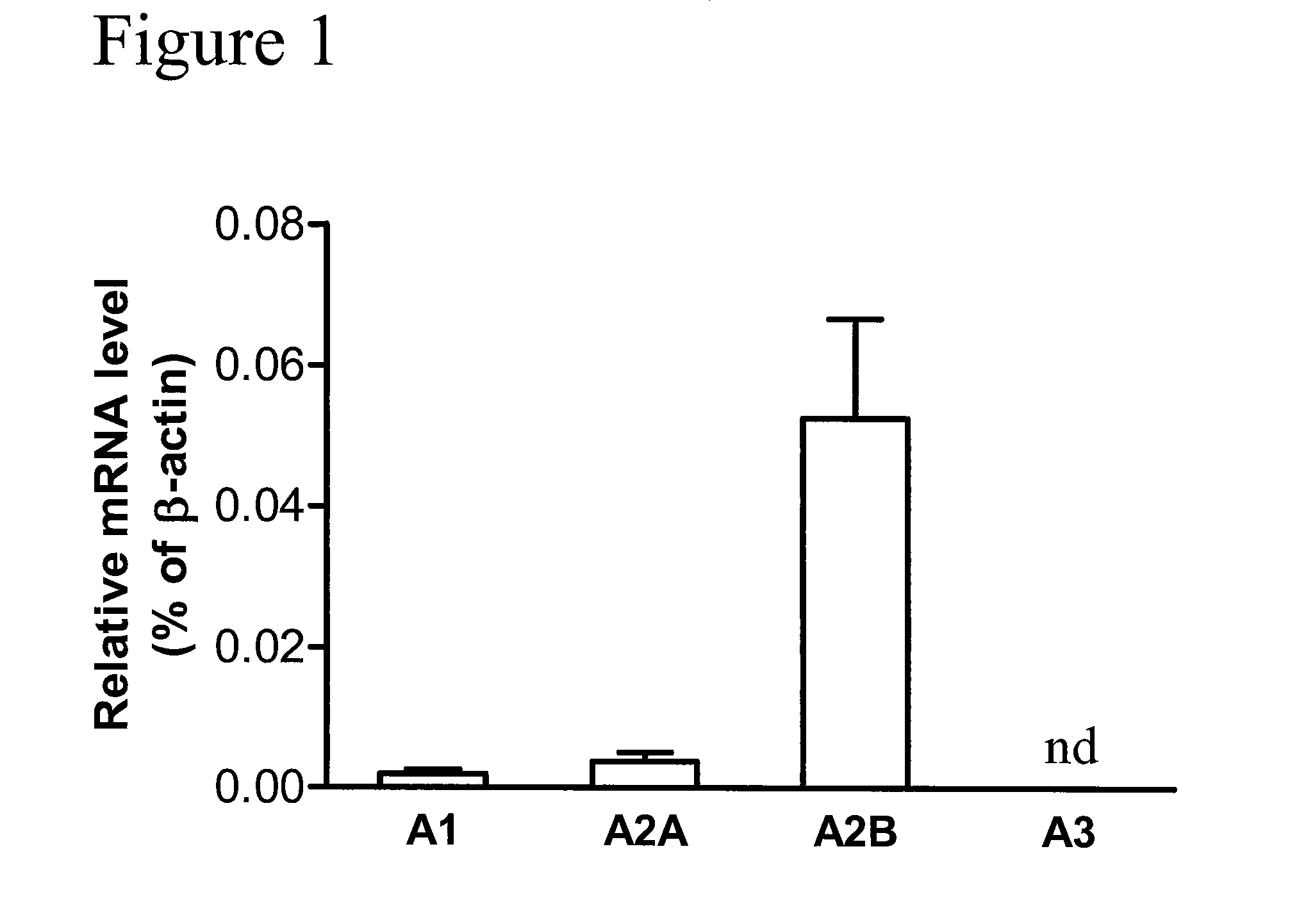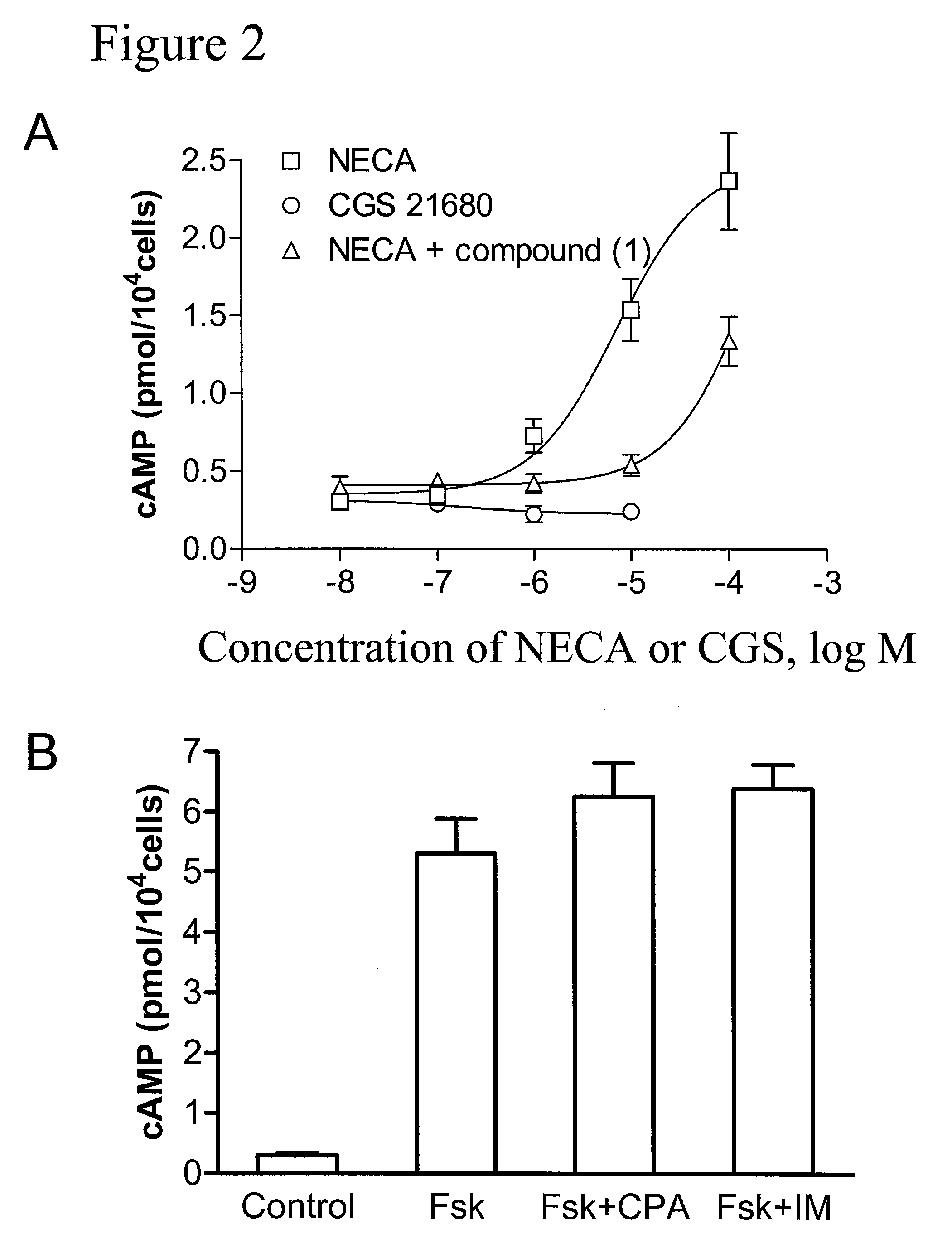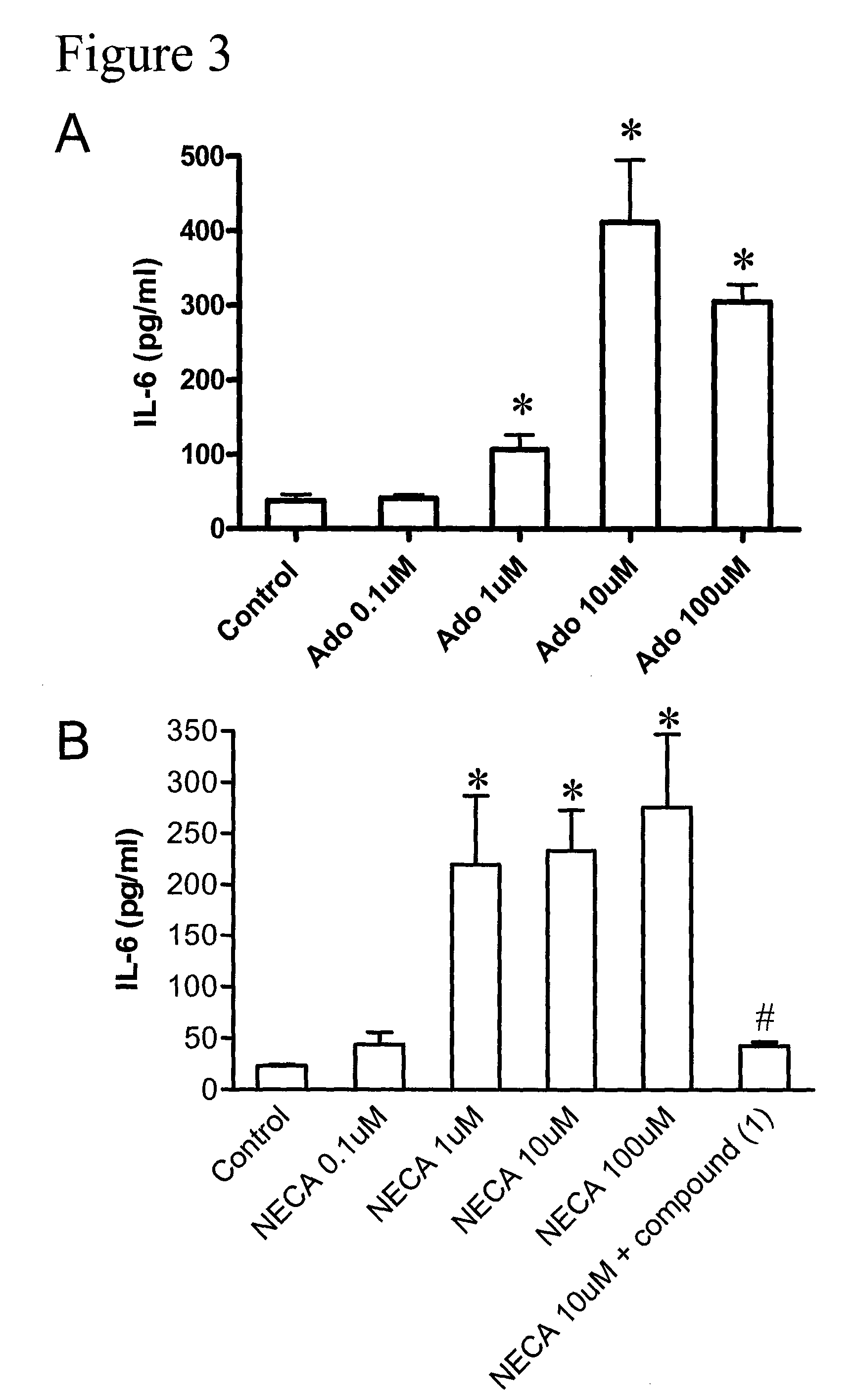Method of treating hepatic disease using A2B adenosine receptor antagonists
a technology of adenosine receptor and adenosine, which is applied in the direction of biocide, heterocyclic compound active ingredients, drug compositions, etc., can solve the problems of liver diseas
- Summary
- Abstract
- Description
- Claims
- Application Information
AI Technical Summary
Benefits of technology
Problems solved by technology
Method used
Image
Examples
example 1
Preparation of a Compound of Formula (5)
A. Preparation of a Compound of Formula (5) in which R2 is Ethyl
[0209]
[0210]A solution of sodium ethoxide was prepared from sodium (4.8 g, 226 mmol) and dry ethanol (150 ml). To this solution was added amino-N-ethylamide (10 g, 113 m mol) and ethyl cyanoacetate (12.8 g, 113 mmol). This reaction mixture was stirred at reflux for 6 hours, cooled, and solvent removed from the reaction mixture under reduced pressure. The residue was dissolved in water (50 ml), and the pH adjusted to 7 with hydrochloric acid. The mixture was allowed to stand overnight at 0° C., and the precipitate filtered off, washed with water and air-dried, to provide 6-amino-1-ethyl-1,3-dihydropyrimidine-2,4-dione, a compound of formula (5).
[0211]1H-NMR (DMSO-d6) δ 10.29 (s, 1H), 6.79 (s, 2H), 4.51 (s, 1H), 3.74-3.79 (m, 2H), 1.07 (t, 3H, J=7.03 Hz); MS m / z 155.98 (M+), 177.99 (M++Na)
B. Preparation of a Compound of Formula (5) in which R2 is Methyl
[0212]Similarly, following the...
example 2
Preparation of a Compound of Formula (6)
A. Preparation of a Compound of Formula (6) in which R2 is Ethyl
[0214]
[0215]A suspension of 6-amino-1-ethyl-1,3-dihydropyrimidine-2,4-dione (0.77 g, 5 mmol) in anhydrous N,N-dimethylacetamide (25 ml) and N,N-dimethylformamide dimethylacetal (2.7 ml, 20 mmol) and was warmed at 40° C. for 90 minutes. Solvent was then removed under reduced pressure, and the residue triturated with ethanol, filtered, and washed with ethanol, to provide 6-[2-(dimethylamino)-1-azavinyl]-1-ethyl-1,3-dihydropyrimidine-2,4-dione, a compound of formula (6).
[0216]1H-NMR (DMSO-d6) δ 10.62 (s, 1H), 8.08 (s, 1H), 4.99 (s, 1H), 3.88-3.95 (m, 2H), 3.13 (s, 3H), 2.99 (s, 3H), 1.07 (t, 3H, J=7.03 Hz); MS m / z 210.86 (M+), 232.87 (M++Na)
B. Preparation of a Compound of Formula (6) in which R2 is Methyl
[0217]Similarly, following the procedure of Example 2A, but replacing 6-amino-1-ethyl-1,3-dihydropyrimidine-2,4-dione with 6-amino-1-methyl-1,3-dihydropyrimidine-2,4-dione, 6-[2-(dim...
example 3
Preparation of a Compound of Formula (7)
A. Preparation of a Compound of Formula (7) in which R1 is N-Propyl and R2 is Ethyl
[0219]
[0220]A mixture of a solution of 6-[2-(dimethylamino)-1-azavinyl]-1-ethyl-1,3-dihydropyrimidine-2,4-dione (1.5 g, 7.1 mmol) in dimethylformamide (25 ml), potassium carbonate (1.5 g, 11 mmol) and n-propyl iodide (1.54 g, 11 mmol) was stirred at 80° C. for 5 hours. The reaction mixture was cooled to room temperature, filtered, the solvents were evaporated and the product of formula (7), 6-[2-(dimethylamino)-1-azavinyl]-1-ethyl-3-propyl-1,3-dihydropyrimidine-2,4-dione, was used as such in the next reaction.
B. Preparation of a Compound of Formula (7), Varying R1 and R2
[0221]Similarly, following the procedure of Example 3A, but replacing 6-[2-(dimethylamino)-1-azavinyl]-1-ethyl-1,3-dihydropyrimidine-2,4-dione with other compounds of formula (6), the following compounds of formula (7) were prepared:[0222]6-[2-(dimethylamino)-1-azavinyl]-1-methyl-3-propyl-1,3-di...
PUM
| Property | Measurement | Unit |
|---|---|---|
| pressure | aaaaa | aaaaa |
| temperature | aaaaa | aaaaa |
| temperature | aaaaa | aaaaa |
Abstract
Description
Claims
Application Information
 Login to View More
Login to View More - R&D
- Intellectual Property
- Life Sciences
- Materials
- Tech Scout
- Unparalleled Data Quality
- Higher Quality Content
- 60% Fewer Hallucinations
Browse by: Latest US Patents, China's latest patents, Technical Efficacy Thesaurus, Application Domain, Technology Topic, Popular Technical Reports.
© 2025 PatSnap. All rights reserved.Legal|Privacy policy|Modern Slavery Act Transparency Statement|Sitemap|About US| Contact US: help@patsnap.com



